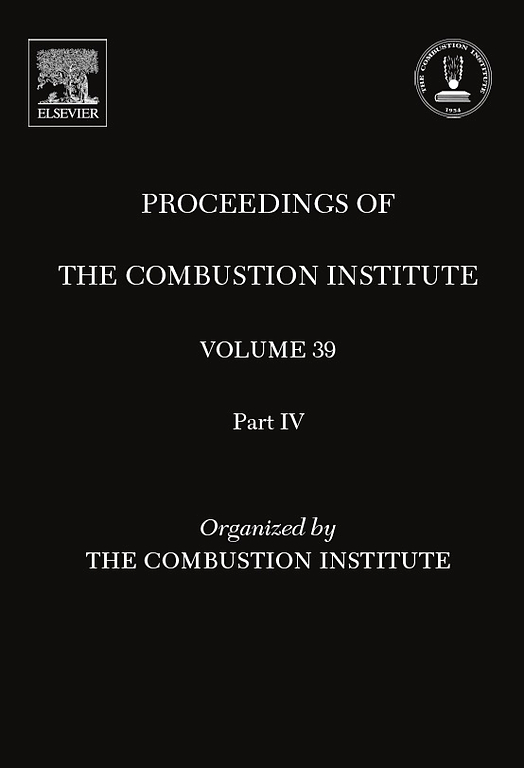矩形管中富氢甲烷的自燃分析
IF 5.3
2区 工程技术
Q2 ENERGY & FUELS
引用次数: 0
摘要
本研究探讨了矩形管内空气中高压富氢甲烷的自燃问题。研究采用了一种计算效率高的方法,在三维大涡流模拟(LES)框架内利用简化的反应机制和点火延迟模型。这种方法克服了传统一维和二维模拟中详细化学模型的局限性,这些模型无法准确再现管内复杂的三维冲击波结构。结果发现,9 兆帕氢气泄漏(情况 1)和 11 兆帕 90% 氢气/10% 甲烷混合物泄漏(情况 2)时的模拟冲击波行为与实验观测结果非常吻合。在情况 2 中,反射冲击波和马赫反射产生的热点点燃了氢气/甲烷-空气混合物,导致三次连续的自燃。据观察,火焰主要沿着管角和管壁中心传播,中心点火蔓延到整个横截面。对于 25 兆帕 24 Vol% 氢气/76 Vol% 甲烷混合物泄漏(情况 6),由于甲烷比例增加,冲击强度显著降低,导致只有在管壁反射半球形冲击波时才会在管角自燃。火焰主要在管角下游形成,并逐渐沿管壁蔓延。研究表明,虽然自燃概率随着甲烷含量的增加而降低,但在足够高的压力下,自燃风险仍然很大。据我们所知,这项研究首次对高压富氢甲烷泄漏到空气中的自燃现象进行了三维大涡流模拟,为了解基本物理现象提供了宝贵的资料。本文章由计算机程序翻译,如有差异,请以英文原文为准。
Analysis of spontaneous ignition of hydrogen-enriched methane in a rectangular tube
This study investigates the spontaneous ignition of high-pressure hydrogen-enriched methane in air within a rectangular tube. A computationally efficient approach has been adopted, utilizing a reduced reaction mechanism and ignition delay model within a 3D Large Eddy Simulation (LES) framework. This approach overcomes the limitations of traditional 1D and 2D simulations with detailed chemistry models, which are unable to accurately reproduce the complex 3D shock wave structures within the tube. The simulated shock wave behavior during 9 MPa hydrogen leakage (case 1) and 11 MPa 90 vol% hydrogen/10 vol% methane mixture leakage (case 2) are found to agree well with experimental observations. In case 2, the hot spots generated by reflected shock waves and Mach reflections ignite the hydrogen/methane-air mixture, resulting in three sequential spontaneous ignitions. The flame is observed to primarily propagate along the tube corners and wall centers, with the central ignition spreading across the entire cross-section. For the 25 MPa 24 vol% hydrogen/76 vol% methane mixture leakage (case 6), the shock intensity is significantly reduced due to the increased methane proportion, leading to spontaneous ignition only at the tube corners when the hemispherical shock wave reflects from the wall. The flame predominantly forms downstream along the tube corner, gradually spreading along the tube wall. It is indicated that while the probability of spontaneous ignition decreases with increasing methane content, the risk remains significant under sufficiently high pressures. To the best our knowledge, this study represents the first 3D large eddy simulation of spontaneous ignition for high-pressure hydrogen-enriched methane leakage into air, providing valuable insights into the underlying physical phenomena.
求助全文
通过发布文献求助,成功后即可免费获取论文全文。
去求助
来源期刊

Proceedings of the Combustion Institute
工程技术-工程:化工
CiteScore
7.00
自引率
0.00%
发文量
420
审稿时长
3.0 months
期刊介绍:
The Proceedings of the Combustion Institute contains forefront contributions in fundamentals and applications of combustion science. For more than 50 years, the Combustion Institute has served as the peak international society for dissemination of scientific and technical research in the combustion field. In addition to author submissions, the Proceedings of the Combustion Institute includes the Institute''s prestigious invited strategic and topical reviews that represent indispensable resources for emergent research in the field. All papers are subjected to rigorous peer review.
Research papers and invited topical reviews; Reaction Kinetics; Soot, PAH, and other large molecules; Diagnostics; Laminar Flames; Turbulent Flames; Heterogeneous Combustion; Spray and Droplet Combustion; Detonations, Explosions & Supersonic Combustion; Fire Research; Stationary Combustion Systems; IC Engine and Gas Turbine Combustion; New Technology Concepts
The electronic version of Proceedings of the Combustion Institute contains supplemental material such as reaction mechanisms, illustrating movies, and other data.
 求助内容:
求助内容: 应助结果提醒方式:
应助结果提醒方式:


